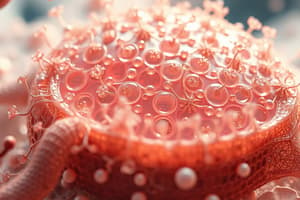Podcast
Questions and Answers
What kind of membrane allows all substances to pass through?
What kind of membrane allows all substances to pass through?
- Selective permeable
- Impermeable
- Semi-permeable
- Permeable (correct)
Which of the following is NOT a characteristic of single-celled organisms?
Which of the following is NOT a characteristic of single-celled organisms?
- They can reach very large sizes. (correct)
- They are limited in their size due to the need to efficiently transport substances.
- They must live in nutrient-rich water.
- They must absorb all necessary substances through their cell membrane.
What is the primary reason for cells being small?
What is the primary reason for cells being small?
- To minimize the potential for genetic mutations.
- To maximize surface area for nutrient exchange. (correct)
- To reduce the amount of energy required for cellular functions.
- To limit the risk of collisions between organelles.
Which of the following best describes the movement of particles during diffusion?
Which of the following best describes the movement of particles during diffusion?
What is the primary role of the cell membrane in preventing toxic substances from entering the cell?
What is the primary role of the cell membrane in preventing toxic substances from entering the cell?
Which of the following describes the process of diffusion reaching equilibrium?
Which of the following describes the process of diffusion reaching equilibrium?
What is the main advantage of multicellular organisms over single-celled organisms?
What is the main advantage of multicellular organisms over single-celled organisms?
What is the role of proteins within the cell membrane?
What is the role of proteins within the cell membrane?
What is the main function of channel proteins or carrier proteins in a cell?
What is the main function of channel proteins or carrier proteins in a cell?
How does diffusion occur in a biological context?
How does diffusion occur in a biological context?
What best describes osmosis?
What best describes osmosis?
What is the primary benefit of diffusion in living organisms?
What is the primary benefit of diffusion in living organisms?
What happens to the concentration of waste oxygen during the diffusion process in muscle cells?
What happens to the concentration of waste oxygen during the diffusion process in muscle cells?
Flashcards
Cell Membrane
Cell Membrane
A structure that surrounds and protects the cell, controlling substance passage.
Permeability Types
Permeability Types
Describes how substances can pass through membranes: permeable, impermeable, semi-permeable.
Diffusion
Diffusion
Movement of particles from high to low concentration until equilibrium is reached.
Equilibrium
Equilibrium
Signup and view all the flashcards
Single-celled organisms
Single-celled organisms
Signup and view all the flashcards
Multicellular organisms
Multicellular organisms
Signup and view all the flashcards
Selective Permeability
Selective Permeability
Signup and view all the flashcards
Role of Cell Membrane
Role of Cell Membrane
Signup and view all the flashcards
Channel Proteins
Channel Proteins
Signup and view all the flashcards
Active Transport
Active Transport
Signup and view all the flashcards
Osmosis
Osmosis
Signup and view all the flashcards
Concentration Gradient
Concentration Gradient
Signup and view all the flashcards
Study Notes
Cell Membranes
- All cells possess cell membranes, which regulate the entry and exit of substances.
- Small molecules readily cross the membrane; medium-sized molecules pass with difficulty, and large molecules cannot.
- Membrane types include:
- Permeable: allows any substance to pass.
- Impermeable: blocks all substance passage.
- Semi-permeable: allows only specific substances.
Diffusion
- Particles are constantly in motion, colliding and dispersing from high-concentration areas to low-concentration areas.
- This movement is along a concentration gradient, which is the term used to describe the gradual change in the concentration of solutes in a solution as a function of distance in a specific direction. This gradient is essential for various biological processes, as it drives the movement of particles, such as ions and molecules, across cell membranes. It serves as a key concept in understanding how substances enter and exit cells, influencing cell communication, nutrient uptake, and waste removal. In essence, the concentration gradient acts as a motivating force for diffusion, leading to the eventual equalization of concentrations in an environment.t.
- Diffusion continues until equilibrium is reached, meaning equal concentrations across the space.
- Equilibrium results in uniform dispersion.
Cell Size and Function
- Single-celled organisms are typically small due to their need to absorb all necessary substances through their cell membrane. They generally reside in nutrient-rich environments.
- Multicellular organisms exhibit greater diversity, size, and dietary versatility.
- Smaller cells provide an efficient surface area to volume ratio for substance exchange and waste removal.
- Larger cells would struggle to obtain adequate substances while producing excess waste and needing more energy.
Cell Membrane Structure and Function
- The cell membrane acts as a selective barrier, controlling the passage of substances.
- Permeability types:
- Permeable: all substances can pass.
- Impermeable: no substances can pass.
- Semi-permeable: only specific substances can pass.
- The membrane prevents harmful substances from entering and removes waste products.
- The membrane comprises two layers of particles with embedded proteins.
- Channel proteins and carrier proteins facilitate the movement of substances across the membrane.
Active Transport
- Active transport utilizes energy to move substances across the cell membrane via proteins.
Diffusion in Cells
- Particles move from high to low concentration regions.
- Diffusion is crucial for nutrient absorption and waste removal.
- Example: Oxygen diffuses from blood to cells during respiration.
- The process continues until oxygen concentrations are equal on both sides of the membrane.
Osmosis
- A specific diffusion form for water.
- Water is essential for all living things.
- Water readily diffuses across cell membranes (until equilibrium).
- This maintains cell size by balancing water concentrations inside and outside the cell.
Studying That Suits You
Use AI to generate personalized quizzes and flashcards to suit your learning preferences.




